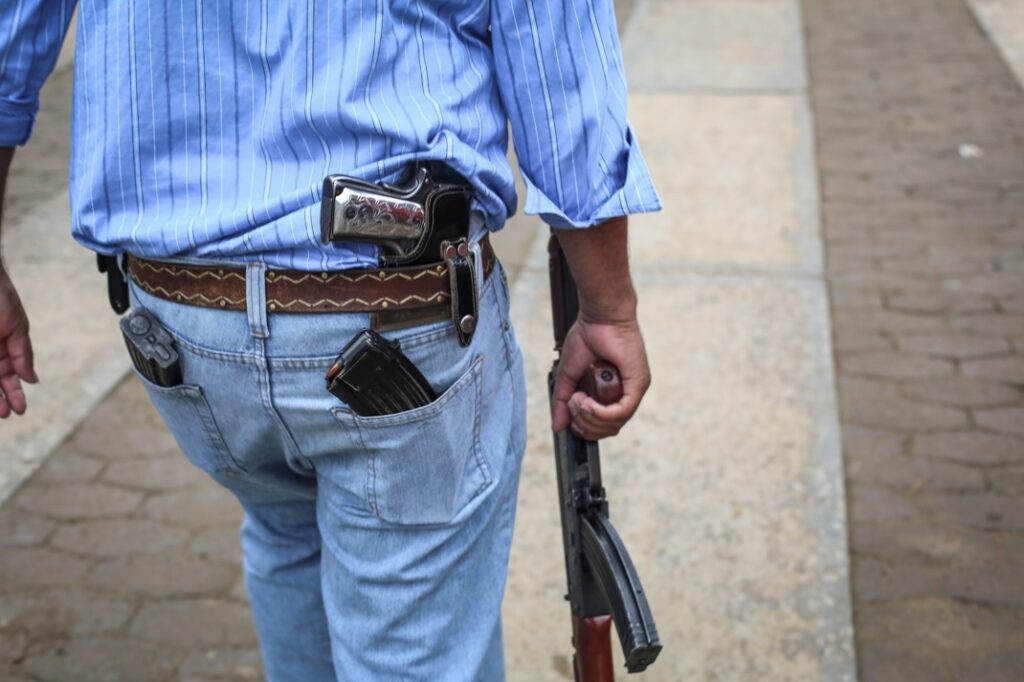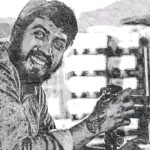Rafa's living room was always a refuge. His entire house was our refuge in those early years when Michoacán, Mexico, was a powder keg. Unstable. Sacrilegious. Unexpected. A permanent barricade. Sheltered by Alma's eternal coffee and Hernán's patience, that house allowed the construction of many versions of the events in which the self-defense groups always ended up being the protagonists.
In some moments of rest or tense calm we would sit with Rafa and listen to the stories of the struggle and organization in Tierra Caliente and the southern highlands while family photos and the television watched us intrigued, who are these people who come and go at all hours?
I asked myself the same question one silent afternoon in July 2013 when, not having much room, I sat down next to Chuy, a man with glasses, cropped hair, but not too much, some gray hair and a curious look almost ready to laugh. His strong body looked like his best years were behind him, he was watching TV attentively and as I sat down he immediately turned his head and with his two-eyed scanner checked me in a second.
I'm Jesús, I'm from Chinicuila, but now I'm around here and in other places, with this movement you have to be from one place to another all the time. But I always return to my town, my mother is sick and I don't want to neglect her. They call me Chuy.
Hi Chuy, nice to meet you, I'm Beto, I'm a journalist and I've been covering the movement since it started, so we'll be seeing a lot of each other here.
Shall I tell you something a little personal? A long time ago I was trained as a military man and they they operated on my eyes to put on glasses so I could see at greater distances. I was also taught to learn a lot of numbers and data with photographic memory, if you want to check it out write me on this sheet all the numbers you want, show them to me once and I memorize them almost immediately.
Who are they?
The gringos. I grew up there, in the United States, and I got into it as a MarinBut then I came here because my mother is alone and sick.
You mean you were part of the gringo army? Now you are self-defense?
Well yes, I was with the "gringos" but then I went back and fought in the cleanup of Chinicuila and now I am seeing where I am most useful, are you going to write me numbers on this sheet so you can see that I am telling you the truth?
During the rest of 2013 I kept meeting with Chuy in Rafa's living room, sometimes we would share opinions on various events that, at the time, seemed to us decisive for the course of the process of armed uprisings and confrontations against organized violence.

Without paying much attention to it, I suddenly stopped seeing him and things began to get more tense in the Sierra-Costa, so we had to pay more attention to this new moment. Rumors were coming in that Chuy had been seen out there, at some barricade, at some outpost, but nothing concrete.
By February 2015, the control achieved by the self-defense groups was visible and allowed the return of certain activities and trades in a fragile, although desired, public life. In the community of Santa María Ostula, for example, a party was organized to celebrate the first anniversary of the frontal combat against the Knights Templar.
Of course a mass preceded the celebration and in the ball of people and security groups in attendance, almost hidden under his hat was a serious Chuy. With a hunting rifle slung over his shoulder, his features had aged considerably and as we exchanged glances we also waved away from the crowd to greet each other calmly. It was then that I noticed his unhurried walk, as if he was overcome by an enormous fatigue.
How have you been Chuy, where have you been?
Well, in many places, in the mountains, in the battles in Aquila, taking care of my mother, it hasn't been easy but today I didn't want to miss this party.
It's good to see you, you can see that there are many comrades who fell, let's see if another day we can sit down and talk more calmly there with Rafa, now there are many people and I have to take some photos and interview some people, but how do you feel the movement is going?
Well, although without the support of several groups of fellow countrymen who are in the United States it would have been impossible to sustain this fight for so long, someday we will have to listen to the people who supported us from there, I know because I still have family there and they were always on the lookout, sending some resources.
You are very right, I would like to know more and maybe go to interview over there.
That was the last time I saw him. Shortly afterwards I learned that with his superhuman eyesight he was able to detect helicopters and decipher truck and vehicle license plates, remembering millimetrically learned data. His ability always amazed and sparked comments.
I finally learned that, in 2016, Chuy, the lone self-defender died of fulminant cancer and that his mother had beaten him weeks earlier. No flag, neither Mexican nor American, adorned his coffin.
Rafa, our generous host, recently told me, in a night of memorabilia of that time, that Chuy was writing to him from the hospital through Facebook, asking him to please send him his writings and tell him his stories, the only ones that at that time of illness gave meaning to the struggle he decided to undertake as a pilgrim.
If anything is necessary in a recounting of this movement, it is perhaps the recounting of those lives and stories of the people who, with their modest participation, gave a more human sense to a war fought between barricades and rocky roads.

Heriberto Paredes Coronel (Tlaxcala, 1983), Mexican freelance photographer and journalist, dedicated to documenting organizational processes in indigenous and peasant communities, the search for missing persons and environmental issues in Mexico. He currently explores formats such as documentaries and podcasts without abandoning photography and text, where he explores new narrative routes. He has collaborated with national and international media, has directed short documentaries and is currently in the development phase of a feature documentary as well as writing a book that brings together more than a decade of work on the Michoacan coast. He lives in Pátzcuaro, Michoacán. Twitter @BSaurus Instagram @el_beto_paredes
You may be interested in: AMLO's military wall


